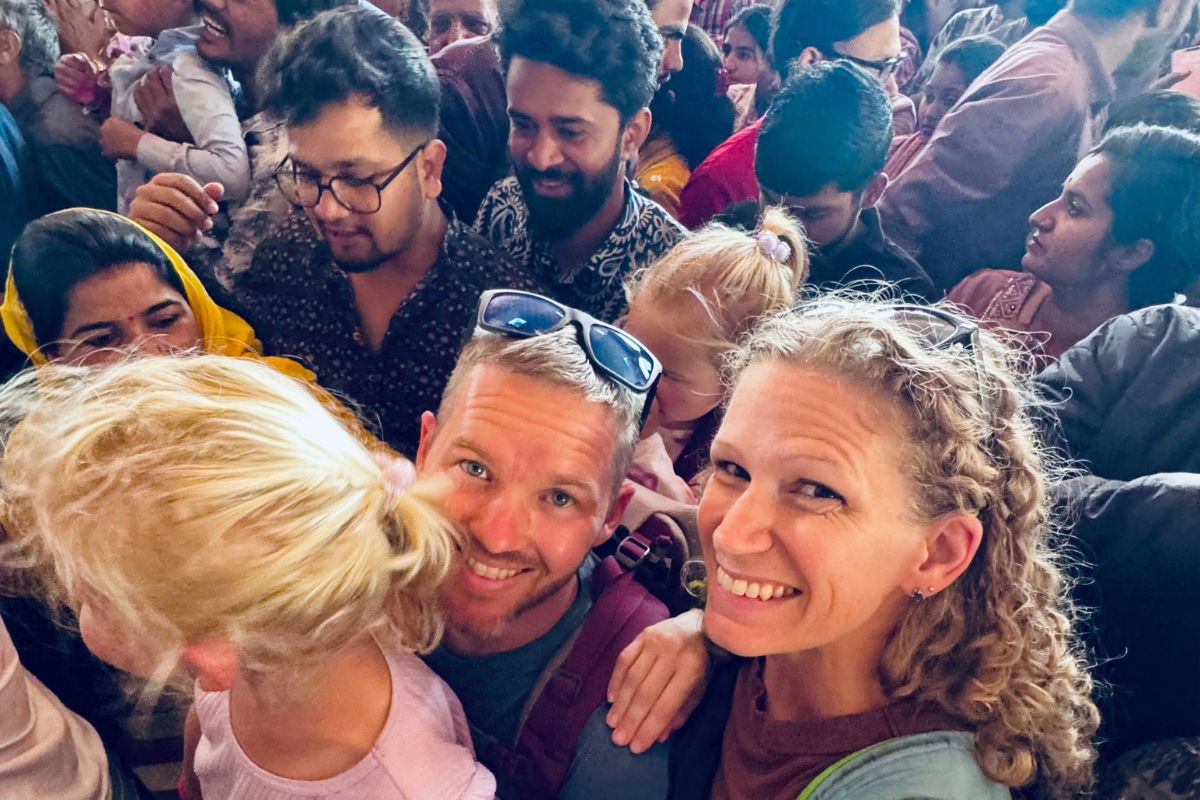If you’re planning a family trip to India, you already know how much prep work is involved—passports, flights, accommodations, and of course, visas. And let me tell you, the E-Visa India process is great…but LONG.
Unlike the old-school method where you’d have to mail in forms and wait weeks, India’s e-Visa system lets you apply online—from your couch, during nap time, or at midnight (because let’s be real, that’s when parents get things done).
However, while it’s convenient, it’s also detailed and time-consuming. Think of it like filling out a passport application for each family member. So grab a coffee, and let’s walk through exactly what you need to know, what mistakes to avoid (trust me, I made some!), and how to get through the process without losing your mind.
What Is an E-Visa India Application?
An e-Visa is an electronic visa that allows you to apply completely online without needing to mail documents, visit a consulate, or wait weeks for processing. It’s one of those things that makes traveling with kids so much easier because:
-
You can apply at any time—whether that’s late at night when the kids are asleep or early in the morning before the chaos begins.
-
No risk of losing paperwork in the mail—everything is handled digitally.
-
It’s way faster than traditional visas, with approvals typically coming through in a matter of days instead of weeks.
However, be prepared—the application is LONG. It’s not a quick “fill in your name and passport number” kind of form. You’ll need to enter detailed information about yourself, your parents, your job, your travel history, and even your maiden name. It’s thorough—almost like applying for a passport.
Why an E-Visa is a Better Choice for Families
For parents juggling a million things, an e-Visa is a lifesaver because you can complete it whenever you have time, even if that means filling it out in 10-minute increments between diaper changes and snack requests.
-
If you were to apply for a traditional visa, you’d likely need to visit an embassy, submit physical documents, and wait weeks for processing—which, let’s be honest, is not ideal when traveling with kids.
-
The Indian e-Visa eliminates all of that hassle and allows you to complete everything from home.
How Long Does It Take to Complete an E-Visa Application?
Set aside at least 20-30 minutes per person to complete the application—more if you need to hunt down details like your parents’ birthplaces or your previous travel history.
-
If you make a mistake, you may need to start over, which adds even more time.
-
Each person, including children, needs their own separate application.
How Soon Should You Apply Before Your Trip?
India recommends applying at least 4-7 days before your travel date, but I highly suggest doing it at least two weeks in advance just to be safe.
-
While most applications are approved within 24-72 hours, there’s always a chance of delays—so don’t leave it to the last minute.
-
Make sure your passport has at least six months of validity left, or your application will be rejected.
Who Can Apply for an E-Visa?
If you’re planning a trip to India with your family, you’ll need to make sure everyone is eligible for an e-Visa before applying.
Who Can Apply?
India’s e-Visa program is available to travelers from over 150 countries, including:
-
United States
-
United Kingdom
-
Canada
-
Australia
-
Most of Europe
If you’re from one of these countries, you can apply for an e-Visa online—no need to visit an embassy or send in documents by mail.
Who is NOT Eligible?
Not everyone can apply for an e-Visa.
-
Pakistani citizens and individuals of Pakistani origin are NOT eligible for the e-Visa.
-
If this applies to you, you’ll need to go through the traditional visa process, which requires applying at an Indian embassy or consulate.
Do Kids Need Their Own E-Visa?
Yes! Every traveler, regardless of age, needs their own e-Visa.
-
Infants and toddlers must have their own separate application.
-
You CANNOT include children under your e-Visa—even if they’re traveling on your lap.
-
Each person must have their own passport—so if your child doesn’t have one yet, make sure to get that sorted first!
What Types of E-Visas Should Tourists Apply For?
Planning a family trip to India? It’s essential to understand there are various e-Visa options available, but here’s the one you’l most likely be using for your trip.
E-Tourist Visa:
Ideal for families, this visa caters to:
-
Recreation and Sightseeing: Explore India’s rich cultural heritage and natural beauty.
-
Visiting Friends or Relatives: Spend quality time with loved ones residing in India.
-
Short-Term Yoga Programs: Participate in yoga retreats or courses.
Duration Options:
-
30-Day Visa: Allows double entry within 30 days from the date of arrival.
-
1-Year Visa: Permits multiple entries; each stay can last up to 90 days.
-
5-Year Visa: Grants multiple entries with a maximum stay of 90 days per visit.
Parent Tip: If you anticipate multiple trips within a year, the 1-Year e-Tourist Visa offers flexibility and convenience.
E-Visa India Requirements for Parents Traveling with Kids
If you’re planning a family trip to India, it’s important to know exactly what documents you’ll need for the e-Visa application. The process is straightforward, but there are specific requirements you must follow for both adults and children.
What Documents Do You Need for Each Applicant?
Every traveler, including children, must apply for their own individual e-Visa. Here’s what you’ll need:
- Valid Passport: Each traveler must have a passport that’s valid for at least six months beyond your arrival date in India. It also needs at least two blank pages for immigration stamps.
-
Passport-Style Photo: A recent, front-facing passport-style photo with a white background is required. It must be in JPEG format and less than 1MB in size. You can take this photo yourself at home as long as it meets these requirements.
-
Travel and Accommodation Details: You’ll need to provide the address of your hotel, Airbnb, or host in India. This helps officials confirm where you’ll be staying during your trip.
-
Flight Details (Optional): While not mandatory, having a confirmed flight can help speed up processing and may be requested during your application.
Do Kids Need Extra Documents?
No special additional documents are required for kids if they are traveling with both parents and have a valid passport. However, each child must have their own separate e-Visa application.
Other Important Things to Know
-
Apply on time: The best time to apply for an e-Visa is at least 4 to 7 days before your trip, but it’s safer to do it at least two weeks in advance to avoid delays.
-
All information must match exactly: If your child’s name or passport details don’t match exactly in the application, it can cause delays or rejection.
-
Print the e-Visa approval: Once approved, print a copy of the e-Visa confirmation (Electronic Travel Authorization or ETA) because you must show it at the airport before boarding. Some airlines will not let you fly without a printed copy.
How to Apply for an E-Visa to India: A Step-by-Step Guide
Applying for an e-Visa to India is straightforward, but it requires accuracy and attention to detail—especially if you’re applying for multiple family members. Here’s a step-by-step guide to ensure everything goes smoothly.
Step 1: Visit the Official E-Visa Website
Go to the official Indian e-Visa portal: indianvisaonline.gov.in
Be cautious of third-party websites that charge extra fees or provide misleading information. Always use the official Indian government website.
Step 2: Start Your Application
-
Click on “Apply here for e-Visa”
-
Choose your nationality and visa type (for most families, this will be the e-Tourist Visa)
-
Apply separately for each family member, including infants and toddlers
Step 3: Fill Out the Application Form
This step takes about 10-15 minutes per application, so be prepared. You’ll need to provide:
-
Personal details (full name, date of birth, nationality)
-
Passport information (passport number, issue and expiry date)
-
Family details (your parents’ full names, even if they’re not traveling with you)
-
Spouse’s details (if applicable)
-
Employment information (your job title and employer name)
-
Travel details (where you will be staying in India, expected arrival and departure dates)
It’s essential that all information matches exactly what’s in your passport. Any mistakes can lead to delays or rejection.
Step 4: Upload Required Documents
The application requires you to upload two documents:
-
A passport-style photo
-
Must be a recent front-facing photo with a white background
-
File format: JPEG
-
Maximum size: 1MB
-
-
A scanned copy of the passport’s personal information page
-
File format: PDF
-
Maximum size: 300KB
If your images are too large, you may need to resize them using an online tool.
Step 5: Pay the Visa Fee
Once you complete the form and upload documents, you will need to pay the visa fee online.
-
Payment methods typically include credit or debit cards
-
Fees vary depending on the type and duration of the visa
-
There is a non-refundable processing fee, so double-check all details before submitting
Step 6: Wait for Processing
-
Processing usually takes 24 to 72 hours, but it’s best to apply at least one to two weeks before your trip
-
You’ll receive an Electronic Travel Authorization (ETA) via email once your application is approved
-
If your visa is delayed, check your email for any requests for additional information
Step 7: Print Your E-Visa Approval
Once approved, print a copy of your e-Visa confirmation (Electronic Travel Authorization or ETA).
Some airlines will not let you board the plane without a printed copy, so do not rely on showing it on your phone. Keep a backup copy in your carry-on.
How Much Does an E-Visa to India Cost?
The cost of an e-Visa for India depends on the type of visa and its validity period. If you’re traveling as a family, it’s important to understand these costs in advance so you can budget accordingly.
E-Visa Fees for Tourists
-
30-Day e-Tourist Visa
-
Cost: $25
-
Validity: 30 days from the date of arrival in India
-
Entries: Allows double entry
-
-
1-Year e-Tourist Visa
-
Cost: $40
-
Validity: 365 days from the date of issue
-
Entries: Allows multiple entries; each stay can last up to 180 days per visit for most nationalities
-
-
5-Year e-Tourist Visa
-
Cost: $80
-
Validity: 5 years from the date of issue
-
Entries: Allows multiple entries; each stay can last up to 180 days per visit for most nationalities
-
Tip for Families: If you think you might return to India within a year, the 1-year e-Visa is a better value than applying for multiple short-term visas.
Additional Fees and Costs
-
Processing Fee: A 2.5% bank transaction fee is added to the e-Visa cost when making the payment online.
-
Non-Refundable Payment: Once you submit your application, the fee is non-refundable, even if your visa is rejected.
What to Expect at Immigration with an E-Visa to India
So you’ve landed in India—now what? If this is your first time entering with an e-Visa, here’s exactly what you need to know to get through immigration without any issues.
Documents You Must Have Ready
- Printed e-Visa Approval (Electronic Travel Authorization or ETA)
-
- Even though it’s an electronic visa
you must print a physical copy and carry it with you. Indian immigration officers will require it upon arrival. Do not rely on showing it on your phone.
-
- Valid Passport
-
- Your passport
-
-
must be the same one you used when applying for your e-Visa. It should also be valid for at least six months from your arrival date and have at least two blank pages for immigration stamps.
Step-by-Step Immigration Process
When you arrive at the airport, follow the signs for Immigration and look for the e-Visa counter. The process is generally straightforward but can take time, especially during busy hours.
-
Document Verification
-
The immigration officer will check your printed e-Visa approval and passport.
-
They may ask you a few basic questions about your visit, such as why you’re coming to India, how long you plan to stay, and where you will be staying.
-
Fingerprint Scanning and Digital Photo
-
Adult travelers will have their fingerprints taken electronically.
-
A live digital photo of every traveler will be taken for identity verification.
-
Passport Stamping
-
Once the officer verifies your documents, they will stamp your passport with the e-Visa entry stamp.
-
This stamp is your official entry record, so make sure everything is correct before leaving the counter.
Do Children Go Through the Same Immigration Process?
Yes, every child must go through immigration just like adults.
-
Each child must have their own passport and e-Visa.
-
Children will have their photo taken at immigration, but not for biometrics
-
Fingerprint scanning is required for children above a certain age. (Young children and infants were exempt when we visited.)
Final Tips for a Smooth Immigration Experience
-
Print your e-Visa and keep it in your carry-on. Do not put it in checked luggage.
-
Make sure all family members’ passports are easily accessible. Avoid last-minute scrambling.
-
Keep a pen with you. You will be required to fill out a health form on arrival form.
Final Thoughts
The Indian e-Visa makes traveling so much easier—but it’s detailed. Set aside time to do it right, double-check your details, and always print your approval.
Now go enjoy your family adventure!
More on the Blog:
Check out how much we spent in Delhi for one week as a family of 4.






